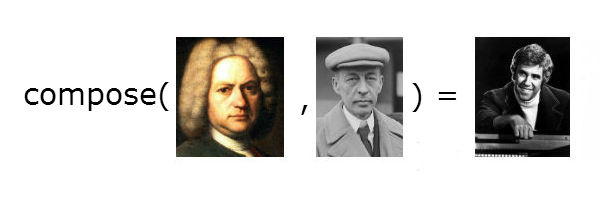Compose Yourself: Fun with Functions
Scott Sauyet
Javascript is the love-child of Self and Scheme
- From Self, a powerful, if somewhat unusual, OO system
- Dynamic dispatch
- Encapsulation
- Polymorphism — lots of it (weak typing!)
- Inheritance through the prototype chain
- Open recursion — through `this`
- From Scheme, the most important features of functional languages
- First class functions
- Closures
We're going to ignore the OO stuff altogether and focus on one application of first-class functions.
New Functions From Old!
Functional Composition chains together functions to create a new function.
Techniques
There are many ways to create compose functions. We'll
examine a few of them.
We will glance at the implementations, but mostly focus on the APIs
presented by these techniques.
Our Test Functions
We will use these functions for our tests throughout:
Question: What value will this code yield?
Mathematical Composition
In mathematics f ∘ g (pronounced "f composed with g") is the function that given x,
returns f(g(x)).
So if we follow the mathematical model compose(add1, square)(x) should equal add1(square(x)).
Simplest Implementation
Several flaws
This naive implementation has at least two flaws:
- It loses track of the
this context used to call it.
- It ignores all but the first argument passed to the initial function.
But it's simple to fix those:
Prototype Manipulation
We can make composition a property of all functions by modifying the Function prototype.

This example doesn't work in this presentation sandbox, but will work in browser. It can be demoed in the console.
There are those who will tell you not to alter the native prototypes, and perhaps they have good points, but ...
Multiple functions
It's easy enough to extend this to multiple functions:
This is very similar to Underscore's code.
We could do this with the prototype version as well, although that might feel strange.
Argument Types
Our examples have used functions that returned the same type they accepted. This is not important. The
essential feature is that each function accept the same type its predecessor generated:
Coding is not Mathematics
Reading these from right-to-left is... odd. There are several options:
We'll look at some ways of doing this next.
Variadic composition through multiple invocations
This API makes it more obvious that the functions should be read from left-to-right:
 Implementation:
Implementation:
Explicit ordering
We can make the ordering of functions entirely explict:
This API makes a miniature DSL out of functional composition, always starting with "first", followed by any
number of "then", "andThen", or "next" clauses, optionally concluding with "finally", "last", or "andFinally".
It is more verbose, but is extremely explicit.
Explicit Ordering Implementation
Operator Overloading
What if we overloaded the right-shift operator?
This doesn't work in this presentation sandbox, but will work in browser. It can be demoed in the console.
Operator overloading in JS? WTF?.
Fake it until you make it!
Fake Operator Overloading Implementation

This doesn't work in this presentation sandbox, but will work in browser. It can be demoed in the console.
Not for real-world usage
This is just a fun exercise to show what can be done. Please don't try this at home!
Wrap-up
To mathematicians, functional composition is a simple concept. Translating it into code can lead to some
interesting and complex API decisions.
There is clearly no right answer. Except for the operator overloading one, every one of those implementations
has a claim to be the one you might choose.
And that's it except for ...
The Obligatory Compose Joke

←
→
/
#

